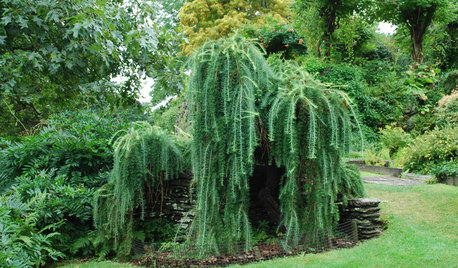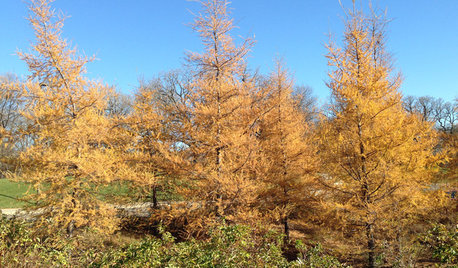Does anyone have a Larix (Larch) of any kind?
Toronado3800 Zone 6 St Louis
9 years ago
Related Stories

GARDENING GUIDESGreat Design Plant: Larix Decidua ‘Pendula’
Soft, graceful and sculptural, weeping larch is a star in northern U.S. gardens
Full Story
GARDENING GUIDESGreat Design Plant: Larix Laricina Glows Gold in Late Autumn
Plant tamarack for a beautiful late-fall golden display
Full Story
INSIDE HOUZZHow Much Does a Remodel Cost, and How Long Does It Take?
The 2016 Houzz & Home survey asked 120,000 Houzzers about their renovation projects. Here’s what they said
Full Story
BUDGET DECORATINGThe Cure for Houzz Envy: Living Room Touches Anyone Can Do
Spiff up your living room with very little effort or expense, using ideas borrowed from covetable ones
Full Story
KITCHEN DESIGNThe Cure for Houzz Envy: Kitchen Touches Anyone Can Do
Take your kitchen up a notch even if it will never reach top-of-the-line, with these cheap and easy decorating ideas
Full Story
MUDROOMSThe Cure for Houzz Envy: Mudroom Touches Anyone Can Do
Make a utilitarian mudroom snazzier and better organized with these cheap and easy ideas
Full Story
BEDROOMSThe Cure for Houzz Envy: Master Bedroom Touches Anyone Can Do
Make your bedroom a serene dream with easy moves that won’t give your bank account nightmares
Full Story
CLOSETSThe Cure for Houzz Envy: Closet Touches Anyone Can Do
These easy and inexpensive moves for more space and better organization are right in fashion
Full Story
HOME OFFICESThe Cure for Houzz Envy: Home Office Touches Anyone Can Do
Borrow these modest design moves to make your workspace more inviting, organized and personal
Full Story
DECORATING GUIDESThe Cure for Houzz Envy: Dining Room Touches Anyone Can Do
Get a decorator-style dining room on the cheap with inexpensive artwork, secondhand furniture and thoughtful accessories
Full StoryMore Discussions









whaas_5a
famartin
Related Professionals
Canton Landscape Architects & Landscape Designers · River Forest Landscape Architects & Landscape Designers · Towson Landscape Architects & Landscape Designers · Bedford Heights Landscape Contractors · East Chicago Landscape Contractors · Kahului Landscape Contractors · Lynwood Landscape Contractors · Milford Landscape Contractors · Soddy Daisy Landscape Contractors · Waldorf Landscape Contractors · Bainbridge Island Decks, Patios & Outdoor Enclosures · Champaign Decks, Patios & Outdoor Enclosures · Framingham Decks, Patios & Outdoor Enclosures · Lewisville Decks, Patios & Outdoor Enclosures · Sugar Land Decks, Patios & Outdoor Enclosuresbengz6westmd
hairmetal4ever
ginkgonut
basic
ken_adrian Adrian MI cold Z5
arktrees
gardener365
whaas_5a
salicaceae
Toronado3800 Zone 6 St LouisOriginal Author
wisconsitom
basic
fairfield8619
floral_uk z.8/9 SW UK
wisconsitom
davidrt28 (zone 7)
wisconsitom
bengz6westmd
conifer50
NHBabs z4b-5a NH